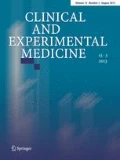References
Yamagishi S, Imaizumi T (2005) Diabetic vascular complications: pathophysiology, biochemical basis and potential therapeutic strategy. Curr Pharm Des 11:2279–2299
Park L, Raman KG, Lee KJ et al (1998) Suppression of accelerated diabetic atherosclerosis by the soluble receptor for advanced glycation end products. Nat Med 4:1025–1031
Enomoto M, Adachi H, Yamagishi S et al (2006) Positive association of serum levels of advanced glycation end products with thrombogenic markers in humans. Metabolism 55:912–917
Nakamura K, Yamagishi S, Adachi H et al (2007) Serum levels of sRAGE, the soluble form of receptor for advanced glycation end products, are associated with inflammatory markers in patients with type 2 diabetes. Mol Med 3:185–189
Humpert PM, Djuric Z, Kopf S et al (2007) Soluble RAGE but not endogenous secretory RAGE is associated with albuminuria in patients with type 2 diabetes. Cardiovascular Diabetology 6:9
Steiner M, Reinhardt KM, Krammer B et al (1994) Increased levels of soluble adhesion molecules in type 2 (non-insulin dependent) diabetes mellitus are independent of glycaemic control. Thromb Haemost 72:979–984
Nakamura K, Yamagishi S, Nakamura Y et al (2005) Telmisartan inhibits expression of a receptor for advanced glycation end products (RAGE) in angiotensin-II-exposed endothelial cells and decreases serum levels of soluble RAGE in patients with essential hypertension. Microvasc Res 70:137–141
Pachydaki SI, Tari SR, Lee SE et al (2006) Upregulation of RAGE and its ligands in proliferative retinal disease. Exp Eye Res 82:807–815
Miura J, Yamamoto Y, Osawa M et al (2007) Endogenous secretory receptor for advanced glycation endproducts levels are correlated with serum pentosidine and CML in patients with type 1 diabetes. Arterioscler Thromb Vasc Biol 27:253–254
Koyama H, Shoji T, Yokoyama H et al (2005) Plasma level of endogenous secretory RAGE is associated with components of the metabolic syndrome and atherosclerosis. Arterioscler Thromb Vasc Biol 25:2587–2593
Kass DA, Shapiro EP, Kawaguchi M et al (2001) Improved arterial compliance by a novel advanced glycation endproduct crosslink breaker. Circulation 104:1464–1470
Author information
Authors and Affiliations
Corresponding author
Rights and permissions
About this article
Cite this article
Nakamura, K., Yamagishi, S., Matsui, T. et al. Serum levels of soluble form of receptor for advanced glycation end products (sRAGE) are correlated with AGEs in both diabetic and non-diabetic subjects. Clin. Exper.Med. 7, 188–190 (2007). https://doi.org/10.1007/s10238-007-0146-7
Received:
Accepted:
Published:
Issue Date:
DOI: https://doi.org/10.1007/s10238-007-0146-7

